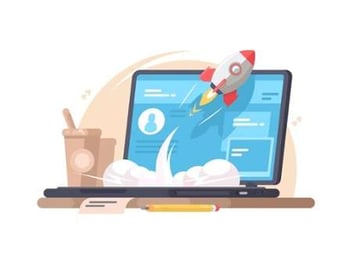Inbound Marketing in Times of Economic Uncertainty
Managing a successful business is challenging, especially during economic uncertainty or a recession. In searching for ways to make your business more resilient, look at the following tips to prepare for tough times, e.g., when large budgets for advertising and outreaches aren't as available anymore. Can Inbound Marketing Solutions accomplish that?

What is Inbound Marketing?
According to HubSpot, Inbound Marketing is a business methodology that attracts customers by creating valuable content and experiences tailored to them. While outbound marketing interrupts your audience with content they don't always want, Inbound Marketing forms connections they are looking for and solves problems they already have.
Inbound Marketing can include the following marketing tactics and methods:
-
Blogs: Leveraging your blog is an excellent example of how Inbound Marketing can be used. A website's blog with various subscription options is useful to keep loyal visitors and customers informed of updates and news without bombarding strangers with new advertisements or undesired outreaches.
-
Content marketing: Using well-written copy, video, or podcast materials goes a long way, especially when establishing awareness and building a business or brand. The right content, personalized and relevant, can help others view your business as reputable and a place of authority, which can, in turn, help generate additional leads and sales in the future. Consider the best combinations of text, audio, and video for your targeted audience
-
eBook/audiobook/gated materials: Sharing or selling an eBook, audiobook, case study, or relevant report you have created for your audience is a well-known element of Inbound Marketing. Providing additional value to your website visitors, they work well with an audience who is already aware of the topic and is curious to learn more.
-
Email marketing: Using email marketing or a customized, personalized newsletter is another way to support and engage your online following. Newsletters and informative notifications, sent to users when they want them, at their pace, are a great platform for those interested in learning more about a service or product.
-
Infographics: The use of visual aids and supporting elements is essential when it comes to engaging your visitors and customers. Infographics can help to catch prospective customers' eyes while keeping core issues, solutions, and relevant topics in front of your audience.
-
SEO: Search engine optimization is a core element to increase your content's relevancy for an audience with a genuine interest in your space, issues, and solutions you are offering. Getting your content targeted and relevant to your target audience is critical in growing your organic search traffic.
-
Social media marketing (SMM): (Organic) Social media marketing, besides SEO, is one of the inbound marketing channels that give visibility to your content elements. Growing your social media audience helps to establish social proof and drive visitors to your website, which is especially helpful in the early stages of content generation, i.e., when organic search traffic is still low.
-
Webinar/podcast: Hosting webinars or podcasts is an excellent way to attract new visitors while implementing other Inbound Marketing techniques. Using a webinar or podcast helps establish your professional personas and authority; it is a great way to establish a long-time loyal following and attract website visitors interested in learning more.
-
White papers: Sharing white papers on your website lends credibility to your business, a critical element of building trust. White papers are also useful tools for announcing new product or service features, updates, reports, or trends relevant to your readers.
Read more about Inbound Marketing and how you can use it to establish and grow your business, increase your long-term marketing ROI, and sustain traction throughout economic challenges as experienced in the pandemic in the early 2020s.
How Inbound Marketing Differs From Other Marketing Approaches
Simply put, Inbound Marketing is like saving for retirement: building for the future while surviving the present. On the other hand, outbound marketing pushes your products and services, hoping you might find a suitable prospect quickly without establishing a lasting foundation for your business. If you stop paying for your PPC ads, your visitor stream stops.
When it comes to Inbound Marketing, it can be simplified as follows: Stop selling; start being helpful to your prospects.
Essentially, being inbound is about attraction, looking to create pull. At the same time, outbound marketing is often called "push" marketing, requiring pushing a message to an entirely new audience and looking to nudge, albeit frequently close to harassing, a desired audience over the finish/buying line. But who wants to be marketed or sold to anymore?
With Inbound Marketing, using relevant pieces of content, planning a podcast around your visitor's wants, and even engaging with social media platforms are all acceptable techniques. Adding value to users who already have an interest in your business or visitors who need your product is what being inbound is all about.
How Inbound Marketing is Different From Content Marketing
Although content marketing can and should be a part of Inbound Marketing, it is not as extensive or as complex as Inbound Marketing; it is a subcomponent.
Content marketing and generating appealing, engaging, and relevant content for your target audience and buyer persona requires keeping up with the latest trends in your industry and markets. As a provider of solutions for the issues of your buyer persona, shouldn't you understand the potentially evolving challenges of those individuals? Of course, you should.
In addition to defining a buyer-persona-targeting content marketing strategy in line with your business objectives, you will need a targeted publication schedule, a consistent calendar, and the ability to interpret and use collected data for future publications and content you create. Which pieces and formats of content resonate most with your target audience? Are you conducting A/B tests to learn what's working and what's not on an ongoing basis and not just once in a while
With the right content marketing strategy, any business can significantly increase its online visibility while solidifying a professional and trustworthy reputation. Defining a content marketing strategy is imperative for any business, brand, or individual looking to establish an online presence of their own.
Inbound Marketing focuses on an all-encompassing (inbound) marketing strategy that includes various tools to build a sustainable future framework. From incorporating content marketing and blog posts to webinars, newsletters, various social media channels, and email campaigns to nurture visitors along their journey, Inbound Marketing is the culmination of all your marketing efforts, resulting in one cohesive strategy.
Why Inbound Marketing is Working in a Recession
The correct application of Inbound Marketing will ultimately save money while streamlining your marketing efforts across multiple online channels. Inbound solutions attract visitors to your website long after you initially implement your Search Engine Optimization or Content Marketing. Using Inbound Marketing creates a ripple effect, impacting and appealing to your audience long after you have finished launching your initial campaigns.
Outbound marketing methods, such as paid social media marketing (SMM), pay-per-click (PPC) campaigns, and cold-calling, require a constant and ongoing investment for continued results. With the sole use of PPC or social media marketing campaigns, no sustained source of visitors is being established, even with consistent efforts.
Inbound Marketing provides stability in recessions or times of economic uncertainty; it is less costly and delivers a long-term impact that outbound approaches cannot provide. With Inbound Marketing you spend more on building your business and a following rather than managing the ongoing expenses of outbound efforts.
How Inbound Marketing Works and Generates Leads
Learn more about the common phases used in Inbound Marketing to understand how Inbound Marketing can support the generation of new leads.
Nobody wants to be sold or marketed to; prospects want to find you as they search for solutions. Remembering this when developing a marketing strategy for your business is imperative. Avoid causing ad blindness or being just plain annoying to your target users by better understanding their wants and needs before you begin promoting your best thing since sliced bread.
Attract Phase
The first phase of Inbound Marketing is the Attract Phase. Here, we are looking to catch new visitors' eyes while being educational for existing users or customers; your products and services are evolving. Commonly used elements in the Attract Phase include:
-
Blogging: Using your blog is another great way to attract new prospective customers; it helps to establish and solidify a professional, credible, and trustworthy reputation. Be educational, not salesy.
-
SEO: Focusing on Search Engine Optimization is also a part of the Attract phase when it comes to developing a long-term marketing ROI Inbound Marketing strategy. SEO matters, especially in highly competitive industries.
-
Social media: Using organic, unpaid social media posts during the attract phase is common; it can establish access to millions of potential users. Social media makes it easy to share relevant or informative content quickly while connecting and engaging with users who are genuinely happy to support your business and brand.
-
Supportive Paid advertisements: While paid advertisements are often used with outbound campaigns, they can be powerful in priming an inbound campaign or increasing conversions with targeted, supportive retargeting efforts.
-
Videos and visual media: Using video media and professionally designed logos and visual media can significantly impact how others view your business and what it provides.
-
Customer reviews and video testimonials are beneficial to establish credibility, especially when expanding in a highly competitive space. Why choose you? Because others already do.
Engage Phase
After you have built an initial audience during the Attract Phase of Inbound Marketing, the next step is to engage and nurture, learning more about your contacts and engaging prospective buyers, and qualifying those who benefit most from your solutions.
-
Automated marketing: Marketing automation and personalization are common and beneficial at this stage, segmenting your audiences and providing relevant information where and when your prospects find it most engaging.
-
Email marketing: Email newsletters are another form of Inbound Marketing that works best to engage users who have already shown an interest in your business or brand. Newsletters can be sent weekly, bi-weekly, or monthly to help you remain actively engaged with your existing audience.
-
Live chatbots: Live chatbots can assist your online visitors by allowing them to navigate your website or make a purchase. They are also extremely beneficial for the raw data they provide.
-
Simplified lead generation: The more data you collect from users via forms, newsletters, and chatbots, the easier it will become to generate leads for a campaign most likely to resonate with your target demographics.
Delight Phase
Once you have connected with your audience and have a solid following, the delight phase is used to connect with your followers and customers continuously.
-
Automated marketing: Marketing automation is essential in many aspects of Inbound Marketing, including long-term marketing ROI strategies in the Delight phase. Your following is growing, and the manual and personalized messaging to targeted segments of your audience will become harder and harder.
-
Blog comments/updates: Engage with users on your blog by responding to comments, asking for input, and even providing valuable and direct feedback.
-
Knowledge Bases: For visitors and customers familiar with your products and services, providing "how to" guidance, lessons, and experiences learned by others is a great way of being helpful.
-
Social media engagement: Continuing engagement with users and customers on social media is a great way to establish and maintain long-lasting relationships.
-
Surveys: Showing a passion and curiosity for what is moving your users and customers is a great way of learning what's working and what's now. It can and should be a key channel to learning and improving your products and services.
How to Measure the Success of Inbound Marketing
Measuring the success of Inbound Marketing is essential for the success of being inbound; after all, what you don't measure is hard to achieve:
-
Bounce rate: How many visitors visit your pages and turn around instantaneously? Because you're attracting the wrong people, those with no interest in your content, or because your content is irrelevant to them?
-
Conversions: How many visitors become fans, e.g., subscribers, of your communications, and how many of them become leads and eventually customers? When and where in the process do they fall off?
-
Cost of Acquisition: How much does the above cost you to convert the anonymous nobody to a customer? Knowing this number and how it varies across channels and over time will have to become the key metric to balance with your lifetime value of a customer and the resulting Return on Investment, ROI. The cost of winning a new customer is usually much higher than maintaining an existing one. Consider offering a hardship policy for existing customers, as many did during the COVID-19 pandemic.
-
Engagement: Your visitors and customers, how much do they reach out to you and leave feedback, positive or negative, and how many come back? Do they consume your content, share and promote it, or skim it for a fraction of a second and never return?
-
Number of Leads: Understanding not just the result of your activities but also the impact of your marketing is essential to measure the number (and source) of leads and, eventually, customers. (Inbound) Marketing, much like any other activity in your business, needs to earn its keep continuously
-
Total Reach: What is the total reach, the number of recipients you are addressing with the Inbound Marketing strategies you have deployed, and are you successful in growing your reach?
Eventually, done right, the ROI and Long Term Impact of Inbound Marketing will outweigh most other Marketing approaches and establish a long-term, compounding contribution to growing your business, especially in challenging times, economic uncertainty, and times of recession.
This content is also available in:
- German: Inbound Marketing in Zeiten wirtschaftlicher Ungewissheit
- Spanish: Marketing entrante en tiempos de incertidumbre económica
- French: Le marketing entrant en période d'incertitude économique
- Italian: L'inbound marketing in tempi di incertezza economica
- Romanian: Inbound Marketing în vremuri de incertitudine economică
- Chinese: 经济不确定时期的入境营销

Joachim is a certified HubSpot trainer with over 13 years of experience in content marketing, strategy, website development, and SEO. He has implemented numerous large-scale, international growth marketing programs, including one with UiPath, which grew from a startup to a successful IPO on the NYSE. Joachim has special expertise in multilingual marketing and sales enablement projects, and he uses the latest AI technologies to help our clients.








Leave a Comment